This Fruity Pain au Levain, with cranberries, raisins, and walnuts, is naturally leavened and makes a lovely canvas on which to practice decorative scoring. You just need to score around the dried fruit and nuts.
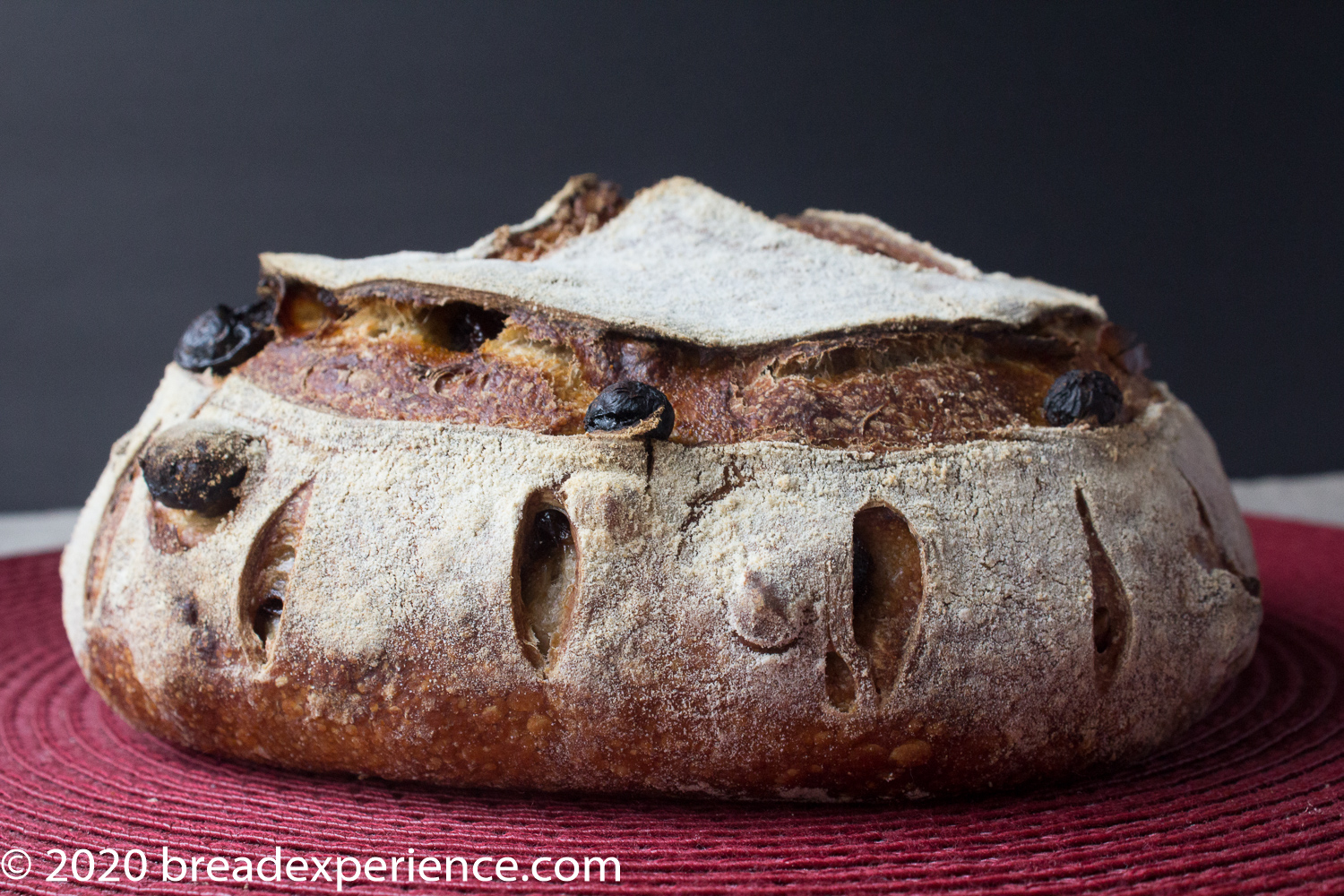
I enjoy the combination of cranberries and walnuts in bread and have made several different versions over the years.
However, this Pain au Levain, with the addition of raisins, as well as cranberries and walnuts, surprised me. I didn’t think I would like the raisins, but I was wrong, they enhance the bread.
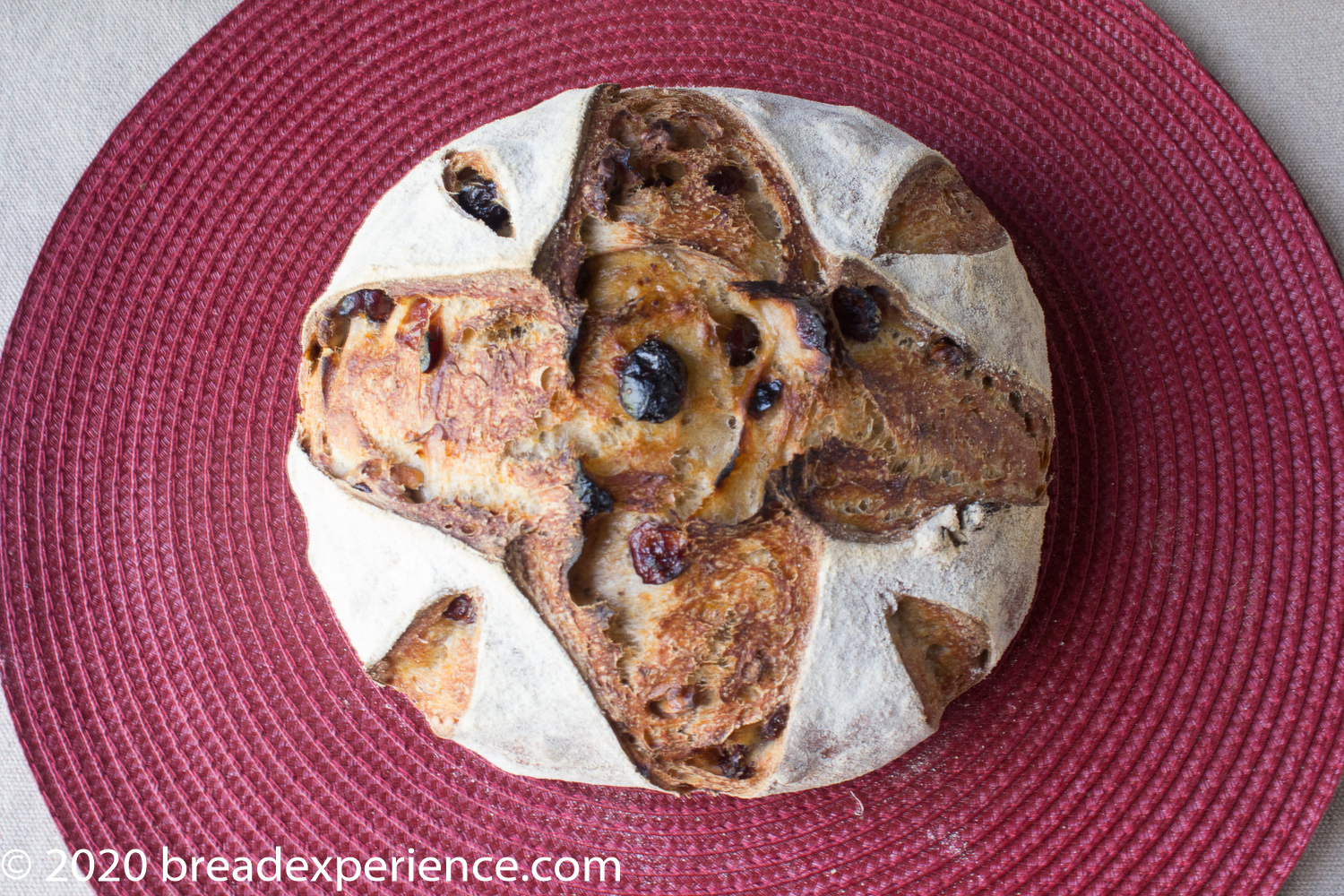
I was introduced to this combination in a master class at the Charlotte Symposium a couple of years ago. Although that one was made with bread flour, rye flour, and polycrop flour. The polycrop flour, from Anson Mills, is a blend of wheat and other crops that are grown together. It was pretty cool!
That bread also utilized a preferment which represented 10% of the total flour. However, when I started making this bread at home, I decided to play around with the amount of preferment to see how it would affect the bread.
This past spring and summer, I made a couple of different types of cranberry and walnut breads for the local farmer’s market. I liked those breads, but I decided to keep on testing.
My experiments led me back to one of my favorite pain au levain breads. One that I learned from Richard Miscovich’s bread workshops at the Asheville Bread Festival and the Kneading Conference in Maine.
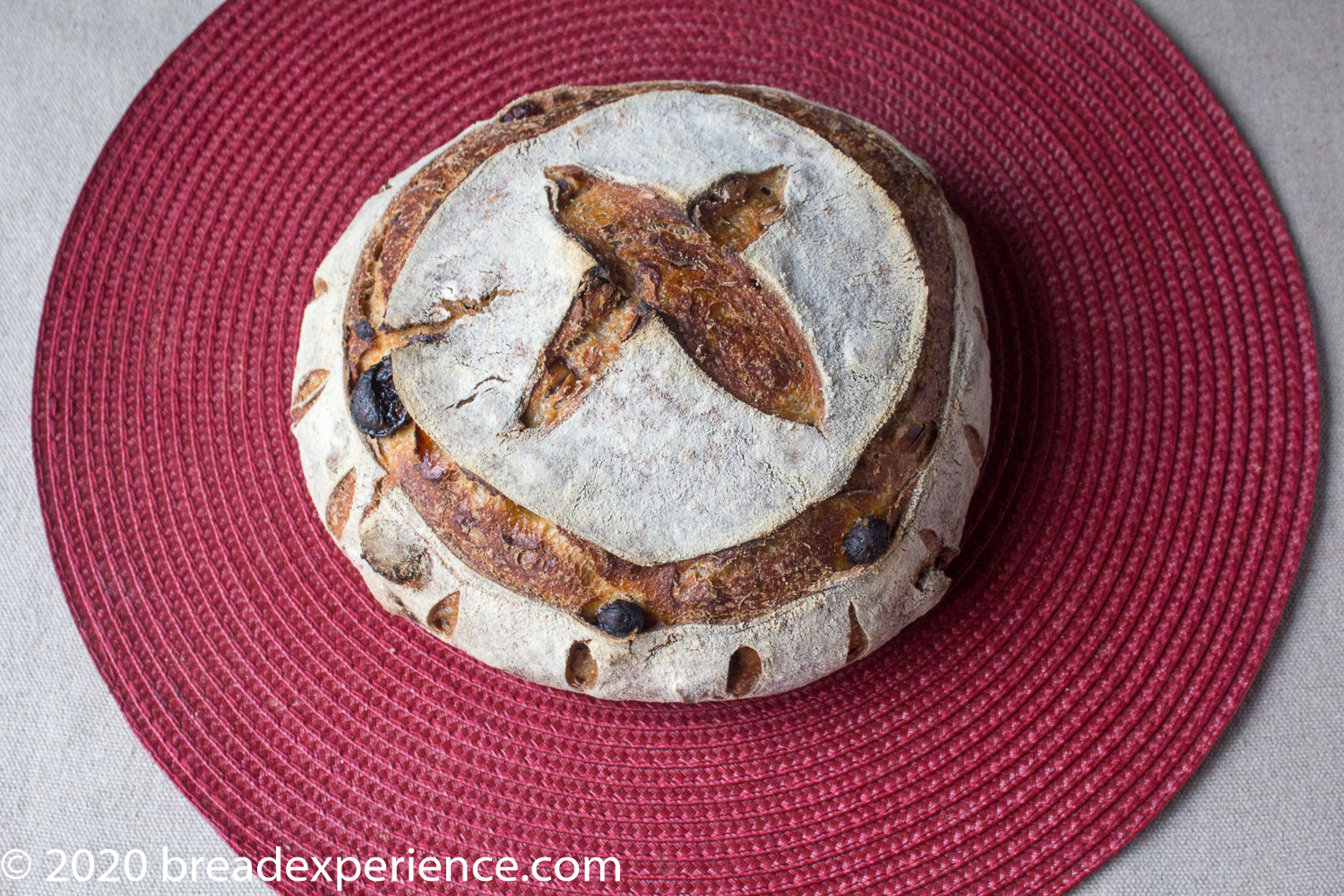
Richard’s formula utilizes about 20% sourdough starter and more flour in the preferment than I had been using recently. Some of the variations I had made recently seemed a bit too sour so I thought this formula might help alleviate that issue.
I also tried another technique to reduce the sourness. Instead of utilizing an overnight preferment at room temperature, I started the preferment in the morning and gave it a shorter rest (about 6 1/2 hours) at a higher temperature (82 degrees F.) using my Raisenne dough proofer. The Raisenne dough proofer reduces the proof time because it proofs at a higher temperature. It’s also lightweight and flat so it can be stored in a convenient place where it’s easy to grab.
In addition, I used finely ground whole wheat flour, which along with the all-purpose flour, provided a lighter crumb. All in all, I liked this bread.
I made it for our Thanksgiving meal and my youngest son liked it a lot. I sent the rest home with him. Unfortunately, I wasn’t able to get a crumb shot, but I will say the flavor and texture were wonderful. The crumb was not full of holes, but I wasn’t aiming for that. Having a tighter crumb works better for spreading with butter. Which is something you want with a Holiday meal.
Print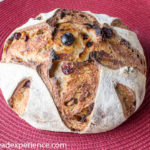
Fruity Pain au Levain with Nuts
- Yield: 1 Large or 2 Medium Loaves 1x
Description
This Fruity Pain au Levain, with cranberries, raisins and walnuts, is naturally leavened and makes a lovely canvas on which to practice your decorative scoring.
Ingredients
Levain
- 227 grams | 1 1/2 cups + 1/2 cup all-purpose flour
- 227 grams | scant 1 cup + 2 Tbsp water
- 45 grams | 3 Tbsp. sourdough starter
Final Dough
- 500 grams all-purpose flour
- 190 grams finely ground whole wheat flour (I used Graham flour)
- 375–400 grams water + 25 – 50 grams (to mix with salt) *
- 16 grams salt
- 45 grams organic sugar
- 55 grams walnuts, chopped
- 55 grams raisins
- 75 grams cranberries
Instructions
Day 1 – Mix the Levain
Option #1 Evening:
- Mix the water and starter together in a large bowl. Add in the flour and mix until completely hydrated. Cover with plastic wrap and let rest at room temperature for 8 – 10 hours.
Option # 2 Morning: (this is the method I used)
- Mix the water and starter together in a large bowl. Add in the flour and mix until completely hydrated. Cover with plastic or bees wrap, place on proofer or warm place (80-82 degrees F.) and proof for 6-7 hours.
Day 1 Evening or Day 2: Mix the Final Dough/Shape Loaves:
- Pour the water over the levain and mix thoroughly with a wooden spoon or whisk to disperse.
- Whisk the flours, salt, and sugar together and add on top of the water/levain mixture. Hold the walnuts, cranberries and raisins until after the autolyse.
- Mix thoroughly using a Danish dough whisk or wooden spoon to begin developing the gluten.
- Cover and let rest (autolyse) for 20 – 30 minutes.
- Add nuts, cranberries and raisins. Thoroughly mix and knead the dough using your fingers.
- Cover and let the dough bulk ferment for 120 minutes. Stretch twice, every 40 minutes. Let the dough rest for the final 40 minutes.
- Divide the dough, pre-shape, and then it bench rest (covered) for 20 minutes before final shaping to allow the dough structure to relax.
- Heavily dust lined or unlined bannetons with rice flour.
- Shape the dough into round boules and place seam-side up in the baskets. If you don’t have a proofing basket, place the loaf seam-side down on a parchment-lined baking sheet to proof.
- Proof for about 30 minutes at warm room temperature. Cover the loaves and place in the refrigerator to cold ferment overnight, 8 – 10 hours.
Day 3: Bake the Loaves
- Place a baking stone or steel on the bottom shelf of the oven and preheat to 450 degrees F. for at least 45 minutes. If you plan to use steam, place a steam pan on the top shelf.
- As an alternative, you can bake these loaves in a preheat bread cloche, Dutch oven or Dutch oven combo baker. (I baked these in a preheated ceramic bread cloche.)
- When the oven is sufficiently preheated, remove the loaves from the refrigerator. Carefully invert the loaves from the banneton proofing baskets (if used) onto parchment paper or a heavily dusted peel. I’ve found that using a lined basket aids with this process. You just carefully peel it off after flipping it over onto the parchment.
- Score the loaves in the pattern of your choice.
- Baking on Baking stone – Slide loaves onto the preheated baking stone and bake for 35 – 45 minutes. A larger loaf will take longer.
- Dutch Oven or Cloche baking – transfer the loaf on the parchment to the preheated Dutch Oven or cloche and place in the oven. Bake for 20-25 minutes with the lid on and 15-20 minutes with the lid off. Remove the parchment paper partway through the bake cycle to allow the bottom of the loaf to firm up.
- Remove the loaves to a wire rack to cool completely before slicing and serving.
Notes
* Adjust the hydration according to the type/blend of flour used. The addition of whole wheat flour makes the dough thirsty and the coarser the blend, the more water it soaks up.
Adapted from Richard Miscovich’s Pain au Levain from the book “From the Wood-Fired Oven”
- Category: Sourdough with Dried Fruit and Nuts
You might also enjoy some of these other Pain au Levain Breads:
https://www.breadexperience.com/einkorn-spelt-pain-au-levain-with/
https://www.breadexperience.com/kamut-pain-au-levain-75-hydrated/
https://www.breadexperience.com/rosemary-spelt-semolina-pain-au-levain/
https://www.breadexperience.com/citrus-pain-au-levain-with-thyme-and-fennel-seeds
Happy Baking!
Cathy
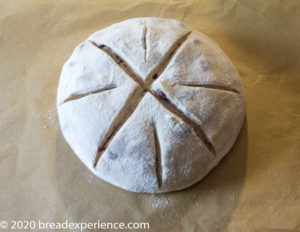
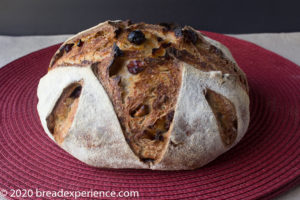
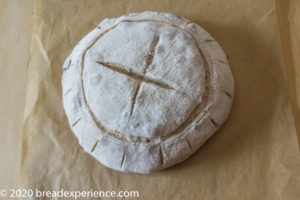
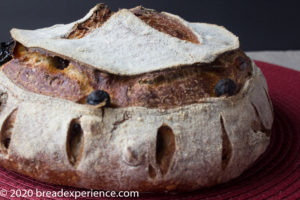
S says
Hi, I loved your recipe and wanted to offer a suggested change in step five to “gently fold in” the inclusions where you currently state “Add nuts, cranberries and raisins. Thoroughly mix and knead the dough using your fingers.” The verb mix with the adverb thoroughly might lead many people to tear the dough thanks to the fruit and nuts. Folding allows inclusions to rest on top of layers of dough. If interested you can watch the lengthy video from Proof Bakery entitled Mixing Inclusions into Sourdough Without Breaking the Gluten or watch a short video demonstration by Northwest Sourdough. Thank you for your recipe.
Cathy says
Thank you for your feedback. I’m glad you liked the bread and that you found a method that works well for you.